|
|
|
|
|
Intel Pentium D 920 and 955 Extreme Edition |
|
Join the community - in the OCAU Forums!
|
Temperature, CrossFire, Summary
TEMPERATURE
Reducing the transistor size is reducing current leakage and heat. But when Intel moved from the 130nm Northwood core to the 90nm Prescott core, heat actually went up. Obviously there are other factors as well, like the quality of the production process, the material used, and of course also the number of transistors. “Smithfield” is sporting 230 million transistors; “Presler” comes with 376 million. This increase is largely due to the doubled L2 cache. More transistors mean more heat. Nonetheless we found that “Presler” is consuming around 5% less power and running 2 to 3 degree Celsius cooler than “Smithfield”. Obviously the impact of shrinking the transistor size from 90nm to 65nm is more than offsetting the fact that “Presler” got quite a lot more of them. Less heat is always welcome; it helps for system stability and overclocking. Nonetheless “Presler” is still running far hotter than AMD dual core products. Even overclocked to 2.9 GHz the FX-60 consumes less power than the 920 at the default speed of 2.8 GHz. The high heat output we have seen since “Prescott” is the result of the 32-stage pipeline NetBurst micro-architecture - and that won’t change until Conroe. The wattage monitoring unit we used reads power consumption at the wall plug. The values shown in the “Power Consumption” chart represent therefore total system consumption and not only CPU power consumption.

975X CROSSFIRE IMPLEMENTATION
The 975X chipset has 2 integrated PCI Express controllers. It supports single x16 graphics or “bifurcated x8” graphics. This is possible because the x16 PCI Express lanes are split up into 2 electrical x16 sockets with x8 bandwidth each. Intel’s 955 chipset allowed only for a single graphics x16 or dual graphics with x8 plus x4 operation. ATI drivers work with the 975X chipset for a CrossFire set-up. The purpose of our test is not a full-fledged investigation into CrossFire. We just wanted to verify the claimed functionality with the new 975X chipset and to get an idea how much the user can gain with CrossFire using a Presler based system.
Depending on the type of video card used, there are two different types of CrossFire arrangement. The following is a quote from ATI’s CrossFire FAQ:
(1) A CrossFire Edition (“master”) and CrossFire Ready card are connected by an external cable. The cable is attached from the CrossFire Ready graphics card’s DVI connector to the CrossFire master’s DMS connector. The partially rendered image is sent through the DVI connection to the master card’s DMS input connector. The partially rendered image from the cable input is combined with the CrossFire Edition’s partially rendered frame in the compositing engine. The compositing engine combines the result of both cards to output a complete image.
(2) Radeon X1300 and X1600 CrossFire Ready cards do not require an external connector. CrossFire mode is enabled via software and the cards communicate over the PCI Express bus.
We first tested with two 850XE cards, and then with two X1300 Pro cards. The 850 XE CrossFire master card went into the first x16 socket and the second card, a regular 850XE, in the second socket. Then the two 850XE cards were connected as described above. For the second set-up we simply plugged 2 identical X1300 Pro cards into the 16x sockets – no cable connection between them is necessary (or possible).
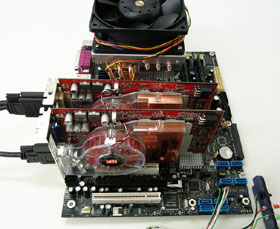 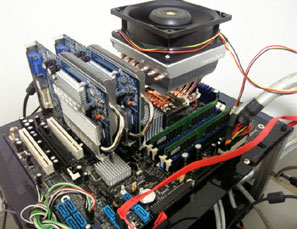
850XE's (left) and X1300 Pro's (right) in CrossFire
In both cases the ATI “Catalyst Control Center” utility immediately recognized the presence of the second video card and allowed to run the duo in “CrossFire” mode.
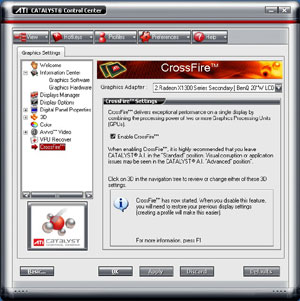
With the 955 XE running at 4066 MHz the 3DMark06 graphic score was going up from 2613 to 4454. That’s an impressive gain of 71%, almost as much as the 80% ATI is claiming for CrossFire. The performance gain with two X1300 Pro running in CrossFire mode was also around 70%: We obtained a graphic score of 1515 with a single X1300 Pro, and 2566 with 2 of them in CrossFire.
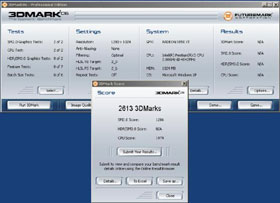 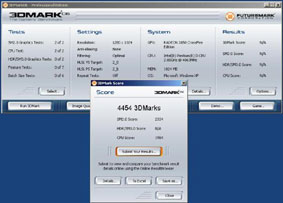
SUMMARY AND FINAL WORDS
The move to 65nm production technology is all good news for Intel. “Presler” and “Cedar Mill” were immediately retailing after the launch announcement. This is indicating that high-yielding dies in large quantity were available right from production start - something which is not always a given, considering how many “paper” launches we have seen from both Intel and AMD in recent years. Performance is up, and heat slightly reduced. Commercially the move to 65nm is beneficial for Intel as more dies can be produced from one wafer. Presler’s high overclocking potential indicates that 65nm technology will allow Intel to ramp up core frequency even further, be it for the existing 9xx series or later for “Conroe”. Unlike the move from 130nm to 90 nm 2 years ago, this time Intel got it right.
On the other hand: Despite all improvements the Pentium D cannot beat the dual core competition from AMD. Intel could narrow the gap, but for the time being AMD’s FX-60 remains the fastest dual core desktop processor. AMD will introduce a new platform with DDR2 support and a new socket in June 2006. The M2 platform will make the current Toledo based FX-60 somewhat obsolete, as it cannot run on the upcoming, faster motherboards. It’s questionable that someone will spend more than 1,000 US$ or 1,500 AUS$ for a processor he cannot run on a soon to be released faster platform. Not less important for the FX-60 and 955 XE target group of PC “enthusiasts” is that the “Toledo” based FX-60 core seems to be largely maxed out. The 955EE has far higher overclocking potential. At the maximum stable frequency of 4.360 GHz we achieved with air-cooling, it was besting a FX-60 at 2.90 GHz in most benchmarks. For dual core entry-level products we see the situation like this: The X2 3800+ runs faster in gaming than a Pentium D 920. In applications both processors run neck-to-neck with a slight advantage for the 3800+. On the other hand a Pentium D 920 is between 15% and 20% cheaper and overclocks clearly better: We achieved with air-cooling a 45% frequency increase and believe that 40% (or around 3900 MHz) are achievable with almost every air-cooled 920. Overclocked to its maximum stable frequency we found the 920 outrunning a maxed out X2 3800+ in almost all benchmarks.
To sum it up: The general battle order between Intel and AMD has not changed with the introduction of the 9xx series, but Intel’s single and dual core desktop products have improved their relative position quite a lot to their advantage.
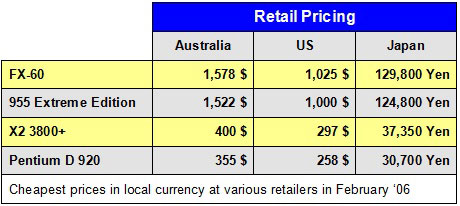
2006 is becoming a very exciting year. Intel has made a strong first move with the successful change to 65nm production technology. AMD has answered with the FX-60. In April 2006 Intel will release an even higher clocked 9xx series processor. It is said that in June 2006 AMD will introduce the M2 platform with DDR2 800 support. In the second half of 2006 Intel will introduce a new micro-architecture for desktop, mobile, and workstation chips, and AMD will move to 65nm production technology as well. In the meantime Intel is already preparing 45nm production technology - a working sample was demonstrated in January 2006. There is good reason to watch out for these developments because hardware bought in 2006 might soon become obsolete. For the time being we recommend a buyer considering an entry level dual core processor to have a good look at Intel’s Pentium D 920.
Additional Info:
975X Chipset: here
9xx Processor Series: here
Moore’s Law: here
65nm Production Process: here
|
|
Advertisement:
All original content copyright James Rolfe.
All rights reserved. No reproduction allowed without written permission.
Interested in advertising on OCAU? Contact us for info.
|

|


